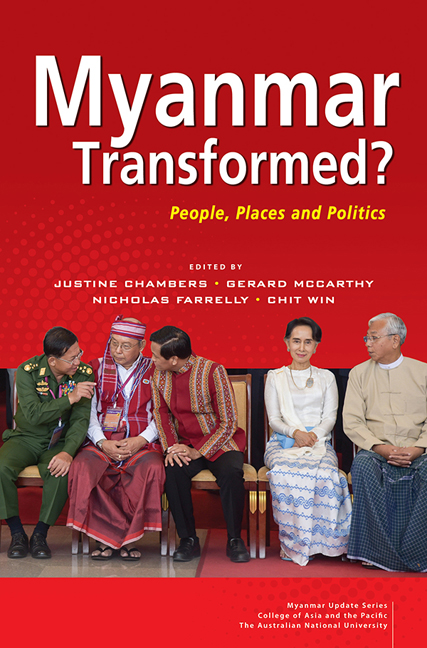Book contents
- Frontmatter
- Contents
- List of Tables
- List of Figuress
- Acknowledgements
- Contributors and Editors
- Part I Introduction
- Part II People
- Part III Places
- 5 Myanmar's Rural Revolution: Mechanization and Structural Transformation
- 6 Change and Continuity: Capacity, Coordination and Natural Resources in Myanmar's Periphery
- 7 Advocacy Organizations and Special Economic Zones in Myanmar
- 8 Explaining Naypyitaw under the National League for Democracy
- Part IV Politics
- Part V Epilogue
- Abbreviations and Key Terms
- Index
5 - Myanmar's Rural Revolution: Mechanization and Structural Transformation
from Part III - Places
Published online by Cambridge University Press: 12 February 2019
- Frontmatter
- Contents
- List of Tables
- List of Figuress
- Acknowledgements
- Contributors and Editors
- Part I Introduction
- Part II People
- Part III Places
- 5 Myanmar's Rural Revolution: Mechanization and Structural Transformation
- 6 Change and Continuity: Capacity, Coordination and Natural Resources in Myanmar's Periphery
- 7 Advocacy Organizations and Special Economic Zones in Myanmar
- 8 Explaining Naypyitaw under the National League for Democracy
- Part IV Politics
- Part V Epilogue
- Abbreviations and Key Terms
- Index
Summary
Development economists see structural transformation—the process by which labour leaves the rural agricultural sector for the more productive urban industrial and service sectors—as fundamental to economic development. As progressively more labour relocates from rural to urban zones the former are transformed from labour surplus to labour deficit areas, and a “turning point” is reached when rural wages begin to catch up with urban ones (Lewis 1954). Recent evidence of this pattern can be found in many Asian countries such as Bangladesh and China (Zhang et al. 2011; Zhang et al. 2014). Agricultural mechanization, the process by which capital in the form of machinery is substituted for labour in agriculture, is viewed by agricultural economists as a labour-saving response to labour scarcity and rising rural wages (Binswanger 1986; Takahashi and Otsuka 2009). Binswanger (1986, p. 32) notes that “mechanization is profitable and contributes most to growth where land is abundant, where labor is scarce relative to land and where labor is moving rapidly off the land”. As such, agricultural mechanization can be read as a symptom of structural transformation that helps to maintain the viability of farming in the face of labour shortages and rising production costs (Zhang et al. 2017).
In contrast to this model of development, in which economic and social transformation along the rural-urban axis is predictable and linear in form, recent work by development geographers highlights processes of agrarian transition that are far more complex, partial and varied than the mainstream economics literature would suggest (e.g. Rigg & Vandergeest 2012). For instance, Rigg et al. (2016, p. 118) observe that—contrary to the expectations of most commentators—smallholders in East and Southeast Asia “have persisted in the face of rapid and profound social and economic transformation”. But they do so in a variety of new hybrid forms that reflect the conjuncture of variations in physical geography, mobility, markets, and government policies.
These debates have particular resonance for Myanmar as it emerges from five decades of isolation and becomes more deeply integrated into the regional and global economy. Three processes central to structural transformation have emerged post-2011. First, the economy is growing rapidly.
- Type
- Chapter
- Information
- Myanmar Transformed?People, Places and Politics, pp. 109 - 136Publisher: ISEAS–Yusof Ishak InstitutePrint publication year: 2018



